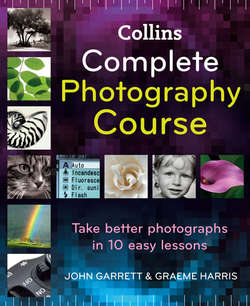Читать книгу Collins Complete Photography Course - John Garrett, Graeme Harris - Страница 28
Quick tip
Оглавление• Your camera’s exposure reading is only a guide to what is deemed correct. As you become more experienced you will want to adjust the reading to suit your own interpretation of the picture.
Handheld incident meters are used to take readings when studio flash units are providing the lighting. Handheld spot meters, which measure the light on a small area, are seldom used by the DSLR or SLR user now because most camera meters offer that facility.
Meter modes
Exposure compensation
Auto exposure lock
Self timer
Meter modes
Most cameras provide you with three exposure modes which evaluate the light reflecting off different areas of the picture.
Matrix mode (Nikon) or evaluative metering (Canon) averages the exposure over the whole viewfinder frame. It is recommended by camera manufacturers for all-round situations but does not work well with exposure compensation or on exposure lock.
Centre-weighted mode meters the whole frame but makes the centre of the frame (as marked in your viewfinder) the most critical. It is ideal for portraits and is also recommended when using strong filtration.
Spot meter mode (Nikon) or partial metering (Canon) takes a reading off a small centre circle (only about 2 per cent of the frame). It is ideal if you have a small but critical area in your frame that you want to be sure is well exposed. This is often much brighter or darker than the rest of the picture, but you can spot meter it and let the rest of the frame take care of itself.
Exposure compensation
When you are shooting in P, S or A modes the camera automatically calculates the exposure. If you want to override its reading, use exposure compensation. By pressing the button and rotating the control wheel you have a choice of making the pictures brighter or darker (shown on the camera as + or – respectively).
This can be useful when you have a light subject in front of a dark background, for instance, when you may need to give less exposure than the camera has calculated because it is trying to record detail in the dark background and will make your lighter subject in the foreground too bright. Conversely, if you have a dark subject in front of a bright background you may want to give more exposure.
Auto exposure lock (AE AF)
If your subject is off-centre in the viewfinder the exposure could be incorrect. The answer is to select centre-weighted or spot metering, put the subject in the centre of the viewfinder and hold the shutter button halfway down to set the focus and exposure. Use the auto exposure lock, recompose your picture and take the photograph.
Self timer
The self timer delays the shutter release, giving you time to push the button then run around to include yourself in the shot. If you don’t have a cable release or remote control to fire the camera on long exposures, use the self timer to avoid camera shake.
